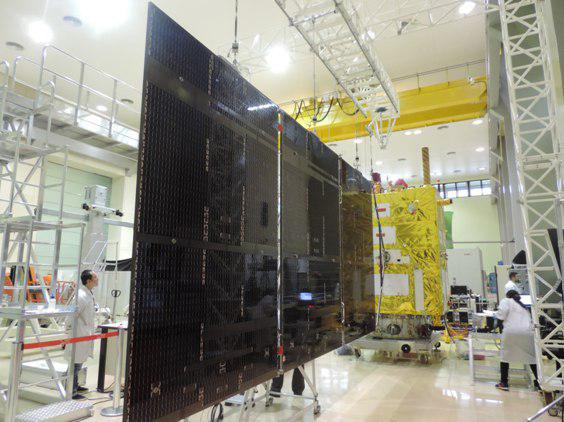Solar Generator is integrated with the CBERS 4A Satellite

CBERS 4A Solar Generator during tests at the Integration and Testing Laboratory,
from INPE, before being sent to China,
The Solar Array Generator (SAG) of the CBERS 04A satellite was tested and integrated this Tuesday (26/11), at the Technical Center of the Taiyuan Satellite Launch Base (TSLC). The satellite will be launched on December 17th, at 00:21 (Brasília time), by the Chinese Long Marcha 4B rocket. The Chinese Academy of Space Technology (CAST) is responsible for developing the CBERS Program satellites on the Chinese side and the National Institute for Space Research (INPE), on the Brazilian side.
For panel opening and lighting tests, the SAG is mechanically and electrically connected to the satellite. The SAG panels are kept suspended from a rail using fixing points, which also allows them to be simulated as they are opened, an operation that will be carried out immediately after placing the satellite into orbit.
The Solar Generator is responsible for capturing sunlight and converting it into electrical energy, essential for the functioning of all systems and subsystems that make up the satellite.
The SAG was made from carbon fiber, which guarantees high strength and durability, and its panels measure 6.3 x 2.6 m (more than 16 square meters), weighing just 55 kilos.
Another highlight at SAG are the highly energy-efficient triple junction cells. At the beginning of their life, they can generate up to 2,300 watts of electrical power.
The Brazilian companies Cenic and Orbital, both located in São José dos Campos, are responsible for manufacturing the SAG, which was sent to China in May this year to be tested and integrated into the satellite, in the laboratory of the Chinese Academy of Space Technology (CAST ).
The CBERS Program, Images and Applications
The CBERS Program (China Brazil Earth Resources or Sino-Brazilian Earth Resources Satellite), created by a cooperation agreement signed by the Brazilian and Chinese governments in 1988, has 50% participation from both countries in its current phase. CBERS 04A is the sixth satellite developed in partnership.
The CBERS Program, with more than 30 years of joint work, is in its second generation of satellites. The CBERS 04A has two Brazilian cameras (MUX and WFI) and one Chinese camera (WPM) on board. MUX will generate 16-meter resolution images, with revisits every 31 days. The WFI has a resolution of 55 meters, with revisits every 5 days, while the WPM has a resolution of 2 meters in panchromatic mode and 8 meters in RGB (Red-Green-Blue, multispectral).
As it has a lower orbit altitude compared to CBERS-4, currently in operation, the images to be generated by CBERS 04A will have better spatial resolution.
Data from the CBERS Program are available to users in the INPE online catalog. The free offering of satellite images, based on an open data policy adopted by INPE in 2004, brings benefits to the country’s various territorial management systems, developed in research institutions, universities and private companies. Furthermore, the CBERS Program, based on the development of space remote sensing technologies, generates jobs, new business opportunities and greater profitability for companies that use satellite images in their services and products.
More information about the CBERS Program: www.cbers.inpe.br

